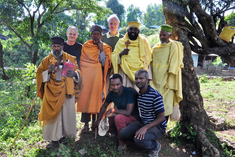Great Wall of Tara Gadam
-

[Translate to English:] The pictures shows the abbot and priests of the Tara Gadam monastery together with CARBOPART project leader Prof. Douglas Godbold, Rektor Prof. Hubert Hasenauer, Dr. Dessie Assefa of Bahir Dar University and Dr. Menale Wondie of ARARI during a recent visit as part of the second phase of the CARBOPART project.
The 1.8 km long protecting dry stone wall was built to protect the native Church Forest of the Tara Gadam monastery as part of the Austrian Federal Ministry for Sustainability and Tourism funded project CARBOPART led by the Institute of Forest Ecology. The native high Church Forest of Tara Gadam is one of the investigation sites within the project. The high diversity church forest found in the Amhara region of Ethiopia is the last remnant of the extensive Afromontane forest that covered the area and is an important biodiversity refugium. The project helping to protect the forest from illegal logging and uncontrolled grazing was requested by the Abbot of the Tara Gadam monastery. The damage to the forest was confirmed in a forest inventory carried out by the Institute of Silvicuture as part of the project. After consultation with the local community carried out by the Centre for Development Research, the wall was built by the local community farmers and the priests at the monastery. The organisation of quarrying and delivery of stones was carried out by the Ethiopian partner in the project ARARI and the district government responsible for the area. Since the completion of the wall, the church forest has been given a protected forest status and extra land has been provided by the district government for expansion of the forest. The site is now being used as an example of an effective forest protection intervention by the regional government of Amhara.
